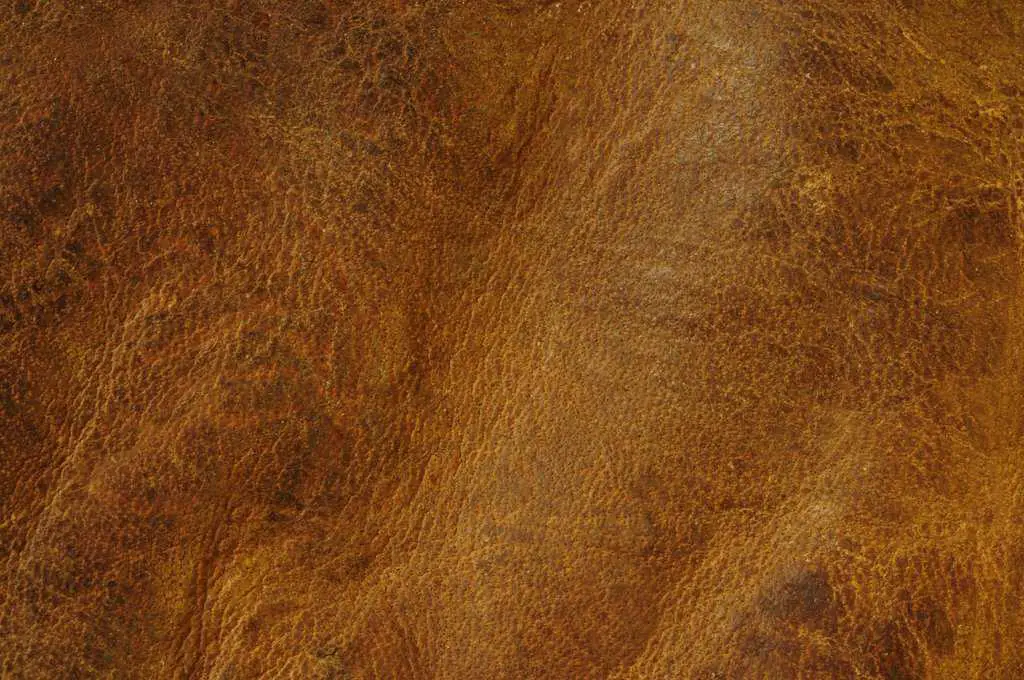One of the best things about leather is that it is a product that lives as you do. It conforms to your lifestyle, your mannerisms, your body, where you place and store it, and more. This may take months or even years to manifest, but there are ways to speed up this process artificially. Here is everything you need to know about aging leather and how to do it.
What is distressed leather and why is it a thing?
Distressed leather is as simple as the name implies. It is leather that has been subjected to stress. It may not be intentional stress, it could refer to scratches through natural wear, or more popularly, the darkening of leather through handling known as patina.
Before the modern technological era we have today, people didn’t think much about aging leather. Leather was a staple material in almost everything. However, with the modern resurgence of all things antique, vintage, and old, it has taken leather with it.

Distressed leather doesn’t have any specific purpose other than aesthetics. The trend of vintage aesthetic and classic fashion has turned worn leather into a modern phenomenon. It is a completely subjective choice to prefer distressed leather products over leather that isn’t. Distressed leather is not better than normal leather, some people just prefer a vintage style.
The leather community is divided over this modern phenomenon as artificial distressing, whether done manually by yourself, or at the tannery, is still artificial distressing. It may be a case of snobbery that leather enthusiasts are not enthralled by people who intentionally “abuse” their leather to make it look older than it actually is rather than the item being loved and taken care of for a long time to naturally give it its distressed look.
We are not the committee on what is right or wrong on leather, however. Whether you enjoy distressed or fresh leather, we are here to give you ways on how you could enjoy your own leather goods better and appreciate the art of leathercraft.
What is patina?
Patina is what gives the leather its unique look and quality. It is achieved through the aging process which takes place on the surface level and is only visible in high-quality and real leather such as full-grain and top-grain leather. The patina is considered the hallmark of high-quality leather and since the weathered look that the patina gives is what gives the item its richness, many leather collectors and enthusiasts look for it in leather items.
You can spot a patina when you see a soft sheen or deeper color on the leather which gives it more character and personality. The patina depends on the type of leather you are using and the different elements that you expose the leather. Elements such as sunlight, heat, rain, movement, and natural oils can all affect how the patina will look on leather.
Not all leather can be distressed
An important thing that you must remember is that not all types of leather can be distressed. This is because not all leathers are strong enough to be distressed. Full-grain and top-grain leather are the only distressable leather as they have the tightest fibers and are very durable.
Suede and genuine leather have looser fibers compared to the latter and that’s why it is not recommended to distress them as their fibers can easily break and significantly weaken the item.
Risks of manually distressing leather
Distressed leather is achieved through normal use and time. While it is possible to achieve this look without using it for years, the process of leather distressing by subjecting your item to high amounts of stress may damage it in a way that isn’t desirable.
As discussed above, it is highly not recommended to use any of these methods on suede and genuine leather, or even faux leather as they cannot withstand the stress applied. They may survive, but suede and genuine leather’s fibers are just too loose and will cause severe fraying and thinning.
How to distress leather
If you have weighed the risks and identified the quality of leather your item has, you are ready to proceed with aging your leather. Here are some of the best techniques to achieve a vintage look to your leather goods such as jackets, boots, chairs, bags, or belts.
How to add patina to your leather
A patina is one of the best ways to distress your leather without compromising it to scratches or wrinkles. If you know anyone with a very old high-quality leather wallet, you will see darker areas that look shiny and silky, which is achieved through regular handling and lots of time.
Patinas do not develop on lower-grade leather, only top-grain or full-grain leather can develop patinas because their fibers are tightly packed and do not fray or break down easily.
Things you will need:
- Your hands
- Denim (optional)
- Sunlight
Steps:
- If you want to develop a patina on smaller items, like leather bags or wallets, it is best to use your hands.
- Rub your hands on the leather and deposit your oils on them.
- You may also rub some denim on a leather backpack or wallet’s edges to deposit some indigo dye on areas that would touch your jeans or denim jacket.
- For large leather clothing items, you may expose them to sunlight for short periods of time to tan over time. You may also expose your smaller items to sunlight.
Tips and extra information:
- Do not expose your items to sunlight for long periods of time. This will dry out your leather and it may make the leather’s fibers brittle which can lead to cracking.
- You may hold the item regularly even if you do not need it to hasten the process.
- A dark, worn-in patina takes a lot of time to develop, even rubbing your hands on it all day cannot beat normal wear for 6 months.
How to achieve a wrinkled look
If you want to avoid doing anything too rough with your leather, this is one safe way to give it an aged appearance. This will not involve any abrasives and irreversible scratches, but you will be applying alcohol, so it is best to still have a presence of mind. This may be used on lower-quality leather, however, you should be more careful as suede and genuine leather are softer and are more easily damaged.
Things you will need:
- Alcohol
- A soft cloth
- Your hands
- Leather conditioner
Steps:
- Clean your item from any dust and debris on the surface. You are distressing leather, but it is still best to avoid any undesirable scratches.
- Apply alcohol to the soft cloth and not directly on the leather to avoid any staining.
- Give the leather a rough massage and crunch it up. Work it in ways you would want it to look aged.
- Apply leather conditioner to return the protective layer that you removed with the alcohol. You only want a distressed look, not easily damaged leather.
Tips and extra information:
- When applying leather conditioner, you may also use your hands to massage and relax the leather once again. The intentional massaging may not make it look very natural, but the leather conditioner can help make it look effortless.
- Using your bare hands to massage the leather will achieve some patina by rubbing your own oils onto the leather. Wallets show this the best as the darker colors are the ones touching your hand the most.
Distress your leather using a plastic bristled brush
This method is commonly used since it doesn’t require hard labor compared to just using your hands. You can only use this method on top and full-grain leather since the brush can be too erosive for low-quality leather and may damage it.
Things you will need:
- Plastic bristled brush
- Alcohol
- Soft cloth
- Leather conditioner
- Shoe wax (if you are doing it on shoes or boots)
Steps:
- Use alcohol and a soft cloth to clean the surface of your item and make sure there is no accumulated debris. The alcohol will also make the leather raw and prep it for distressing.
- Using a plastic shoe brush, brush the areas you want to look distressed.
- Using another piece of soft cloth, apply leather conditioner onto your item to protect it from damage in the future.
- Apply the shoe wax to protect your shoes or boots further.
Tips and extra information:
- Only scuff up the areas that are most exposed like the corners, edges, and straps to make it look more natural and not damaged.
- Do not use a metal or wire brush, this is much too coarse and you will risk the metal bristles digging too deep into the leather.
- You may also apply black shoe polish on the scratched areas to give it a darker appearance. Be conservative with your application.
Sandpaper method
This is one of the riskiest methods. We advise against doing this method unless you are experienced or extremely confident. This is definitely not one to use on genuine or suede as this would destroy its loose leather grain and compromise its integrity.
Things you will need:
- Very smooth sandpaper (2000 grit sandpaper and above)
- Alcohol
- A soft cloth
- Leather conditioner
- Shoe wax (if you are doing it on shoes or boots)
Steps:
- Expose the leather by rubbing alcohol on the surface.
- Choose areas that would be most likely to be scratched up and rubbed.
- Lightly sand, in a singular direction, the chosen areas.
- Rub your hands or another piece of leather on the scratched areas to not make the scratch marks look too fresh.
- Inspect your work regularly. Do not get carried away and overdo it.
- Finish up with some good leather conditioner to protect it from any unwanted damage.
- Apply the shoe wax to protect your shoes or boots further.
Tips and extra information:
- Sand very lightly, you do not want to go too deep into the lower layers of the leather. You just want to scuff up the surface. The lower layers of leather are not as strong. You want to give it an old look, not lessen its lifespan.
- You may use other oils instead of your own hand’s oils to rub the scratched surfaces. You can use coconut oil, olive oil, or mink oil. Waxes may also be an option.
Conclusion
Whether you’re a purist about aged leather or new to the leather hobby, we want you to be able to enjoy your leather goods the way you want it. We welcome everyone from people who are still thinking about buying their first leather item, to people who have a whole collection.
Your leather goods are an extension of yourself, and letting it age with your or artificially aging it to represent your own personality in your own item are ways you can express yourself with your beloved leather items.
We hope this guide has helped you learn more about distressed leather and how to age leather yourself.
FAQ
How do you soften and distress a leather jacket?
The methods mentioned above can apply to all types of leather materials including leather jackets. However, there you can learn more in-depth about softening your leather jacket.
How do you make fake leather look worn?
The thing with fake leather is that unlike full and top grain leather, it will be damaged if you purposely try to make it look worn using distressing elements. The only thing you can do to make fake leather look worn is to actually use it and let time do its thing. However, faux leather doesn’t last very long, so it is best to simply take care of it as much as your can to elongate its life.



